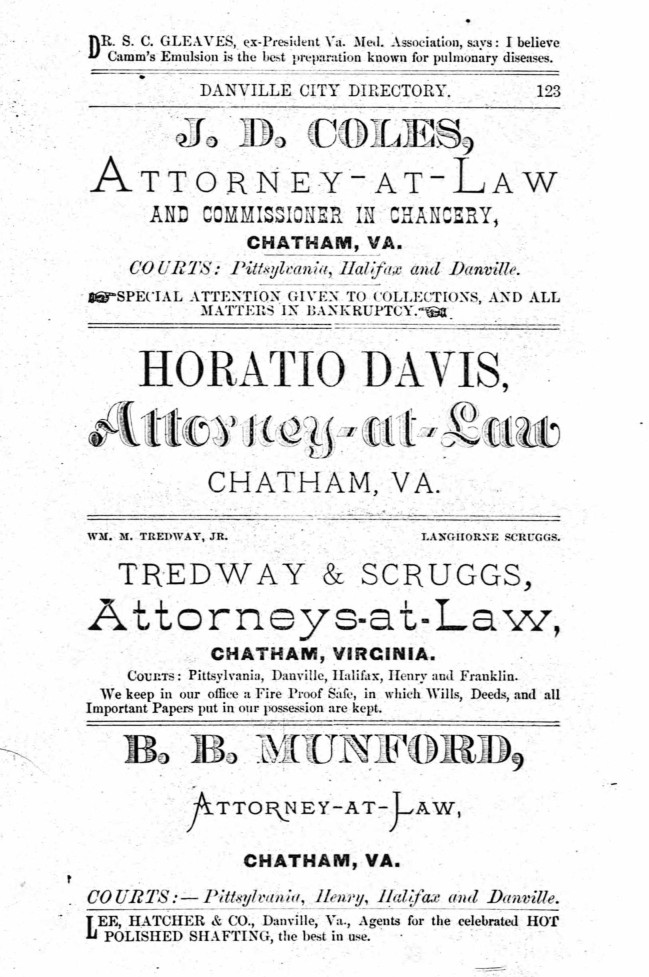
**This research was first published in the February 12, 2025 edition of the Chatham Star-Tribune newspaper as part of Kyle Griffith’s weekly segment entitled “Heritage Highlights.”
Ads for Chatham Attorneys, 1881
Old business directories from the late 1800s are fascinating primary resources to scour for nuggets of information that show the wants and needs of local communities generations ago. The 1881 Danville City directory included brief descriptions of more than thirty communities within Pittsylvania County. In the Town of Chatham, the business directory described it as an exceedingly healthy location with fertile, productive land. “Corn and wheat do well, but tobacco is the main crop. The private residences are large and handsome…the little town is substantial and the stocks of the merchants are large and varied…The Police, Fire, and Sanitary Departments are very efficient and the people are distinguished for intelligence, refinement, and piety.” Accompanying the town’s praises was a list of merchants and services available in Chatham.
General stores were run by R.T. Carter & Co., Hurt & Carter, J.P. Hunt & Co., Johnson & Patton, J.W. Motley & Son, and Thomas S. Jones. There were a selection of shoemakers, including James & John Jones, C.T. Keatts, James Parham, and T.J. Richardson. Before the town went dry, saloons operated under J.M. Adkins and J.B. Mitchell. Sours & Sons ran the town’s foundry while Joseph Davis and B.S. White worked as blacksmiths. The carriage and manufacturing business of Matthias Bolanz served residents when horses were the main way to travel. There were also two tinsmiths: N.L. Price and George W. White. Two mills nearby belonged to George Hodnett and N.A. Moses.
Since Chatham is the location of the county’s courthouse, the other half of the list included various lawyers, attorneys, and local administrators. Circuit court judge Stafford G. Whittle is listed, but he resided in Martinsville. In addition, circuit court clerk Stanhope S. Hurt and deputy clerk J. A. Tredway served during the same time as county court judge Horatio Davis, county court clerk W.B. Shepherd, deputy clerk James A. Coleman, and sheriff W.I. Overbey. Lastly, some of the lawyers who had offices in town included H. & H. Dillard, B. B. Munford, D. H. & James B. Pannill, James L. Tredway, William M. Tredway, and Langhorne Scruggs.
As far as the surrounding communities go, entries in the business directory are sometimes terse. For example, the rural community of Museville was listed as “an inconsiderable little place four miles west of Whittle’s Depot” that included blacksmith P. Adkins, a saloon run by T. R. Cook, general store under Hunt & Tate, as well as a justice of the peace William A.J. Finney. Dry Fork Depot was described as “only a way station and a farmers’ post office” with no list of businesses to provide. Like many other upcoming communities, it was in its infancy.
During those days, Cascade was one of the larger communities in the county with two hundred inhabitants, which was fifty more than lived in Elba (Gretna). Riceville also had one hundred fifty inhabitants, a steam saw mill, a grist mill, two churches, and two schools. The community of Hurt’s Store–about eighty years before it was incorporated as a town–was noted to have one hundred inhabitants. “Iron ore and marble are abundant. There are several saw and grist mills in operation near here. There are also three churches and two schools near. Mails daily.” The mills in reference belonged to sawyers Berry & Lillard, Fitzgerald & Williams, J.H. Graves & Co., and one grist mill under Snow & Roark. Ringgold had about fifty inhabitants and could boast a telegraph and express office, one mill, three churches, and two schools.
The directory mostly groups local communities into several categories: way stations on the railroad, tributary populations, and farmers’ post offices. Only a few communities like Chatham and Bachelor’s Hall received mail twice daily, and most others received it once per day. Cascade got mail once daily except on Sunday, Laurel Grove and Slatesville got mail tri-weekly, and more isolated offices like Riceville received it semi-weekly. Over 140 years ago the business directories were a necessary item to have in order to know where to shop, but today they serve as wonderful records of community life and the rural merchants with long lasting impacts on local history.

